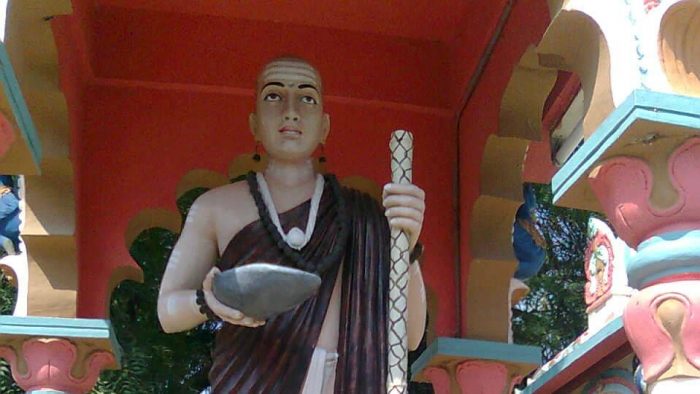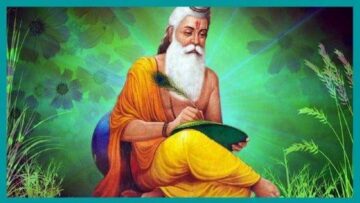Introduction
Advaita Vedānta is perhaps the most pervasive stream of Hindu Darśana-s. Though, most closely identified with Ādi Śaṅkarācārya and the Smārta tradition, the Darśana which bases its teachings on the Prasthānatrayī: Upaniṣad, Brahma Sūtra, and Bhagavad-Gītā, has greatly influenced other Indian traditions and schools of philosophy.
The sub-schools of Vedānta like Viśiṣṭādvaita, Śuddhādvaita and Śivādvaita, though developed in opposition to Śaṅkara Advaita, yet are basically different streams of non-duality itself. The pan-Indian religious texts like the Purāṇa[1], Āgama[2], and Tantra, as well as distinct spiritual traditions like nātha yogins, all show Advaitic influence.
This paper examines the influence of Advaita Vedānta on Sarvajña –one of the most renowned Vīraśaiva saints. He was a Kannada poet and philosopher of the 16th century. He is famous for his three-lined vacanas or poems called ‘tripadi’. These poems deal with a variety of subjects ranging from philosophy and devotion, to ethical guidelines and useful nuggets for daily living. He is often counted among important saints of Vīraśaiva tradition.
The first section recounts a brief biography of Sarvajña and his place in Kannada literature. In section two, the general influence of Advaita Vedānta on Vīraśaiva movement is enumerated. Section three examines some of the vacanas of Sarvajña; and brings forward the underlying ideas of Advaita Vedānta in his teachings.
Sarvajña: His life and works
Sarvajña is among the most renowned saints, poets, and social commentators of Karnataka. Even today, his vacanas are very popular and widely read. However, despite this popularity, very little is known about his life.
He was born in a village called Madagamasuru in Dharwad district (Naikar 2010, ix). In his vacanas, Sarvajña notes that previously he was one of the divine attendants of Lord Shiva named Puṣpadanta, who then took birth on earth first as Vararuci, and then as Sarvajña (Chudamani n.d., 1). His father was Basavarasa, a śaiva brāhmaṇa and the mother was Māli, a woman from the potter community and he was born out of wedlock. In one of the vacanas, he proclaims himself as being born from the blessings of Lord Candraśekhara (ibid., 2). Regarding the period when Sarvajña lived, though the exact dates are difficult to predict, scholars note that he must have lived later than 12th century CE and before 17th century CE (Naikar 2010, xii).
Sarvajña composed his vacanas or poems in the form of ‘tripadi’ or ‘with three pada-s’ written in three-line verse meter, a format very famous in Kannada poetry. Naikar (ibid.) notes that “the people were so influenced by his songs that they learnt them by heart and quoted them on all relevant occasions”. He adds that Sarvajña’s vacanas had as much influence on Kannada society as the Hindu epics. Though Sarvajña claims in one of his poems that he has composed seven crore seven lakh seven thousand and seventy vacanas, Naikar notes that only around 1200 are available in print today (ibid., xii, 2). Thematically they can be broadly classified into: social, religious, philosophical/ ethical, political, scientific, riddles, and miscellaneous poems (ibid., xiv). His contributions to Kannada literature can be compared to those of Tiruvalluvar to Tamil literature or of Vemana to Telugu literature (ibid., vi).
Advaitic influence on Vīraśaiva saints
Despite doctrinal differences between Śakti-Viśiṣṭādvaita and Advaita Vedānta of Ādi Śaṅkarācārya, as the name itself denotes, Advaita or non-dualism forms the foundation of Vīraśaiva philosophy. Thus, we can see that prominent saints like Allama Prabhu explicitly lay out ideas of non-duality in their vacanas.
Consider the following three vacanas by Allama Prabhu that clearly bring out ideas of non-duality and oneness.
i. If I say one, there then are two.
If I say two, there then is one.
On single-dual, now I see
No need at all to ask of thee.
In union free of inner break,
Hair splitting one jot will not make.
For teacher-student, can there be
A bond except identity?
O Lord of the Hidden Caverns (Michael 1992, 32).
ii. Without the duality – mind and mere bone,
For him who has merged his own Self with the Lord,
All actions are actions of linga alone.
With mind given rest from its usual toil,
For him who has merged his own Self with the Lord,
All thoughts of attainment his knowledge be spoil.
Himself into Self having joined with great yoke,
For him there’s no dual, no unity broke,
O Lord of the Hidden Caverns (ibid., 34).
iii. Body is the abode of Pranalinga,
Bathing in Akashagange, Offering flowerless fragrance,
Chanting words ‘Shiva, Shiva’ In lotus heart,
This is Advaita, O Lord Guheshwara (Narayan 2017, 108)!
While general ideas of non-duality as seen above were prevalent across Vīraśaiva tradition since its inception, an attempt at reconciliation and an integration of Vīraśaiva philosophy with Śaṅkara Advaita was done by the 15th century Vīraśaiva saint Nijaguṇa Śivayogi who pioneered the Kaivalya tradition in Kannada literature (Paniker (Ed.) 1999, 190). Thus, it is not surprising that we find many ideas from Advaita Vedānta in the writings of Sarvajña, who lived merely a hundred years after Nijaguṇa Śivayogi.
Advaitic Ideas in the Vacanas of Sarvajña
Even a cursory examination of the vacanas of Sarvajña will show the presence of a large number of Vedāntic terminologies or their Kannada equivalents. Some of the prominent one’s include: Brahman, Ātmā, Māyā, Jyoti, Cidānanda, Advaita, Jñāna, Tattva and Tattvamasi.
A detailed study of the context and the usage of these terminologies will be helpful in discerning the presence of an underlying strong current of Advaita Vedānta in the philosophy of Sarvajña, including his conceptions of Brahman, Māyā, Mukti, and allied themes.
Since the Advaita Vedānta of Ādi Śaṅkarācārya bases its philosophy and worldview primarily on the tenets enunciated in the Upaniṣads, we will try to map the vacanas of Sarvajña using the verses from the Upaniṣads. We would also bring in other textual citations wherever necessary.
3.1. On Brahman / Īśvara
The Upaniṣads deliberate extensively on the question of Brahman or Īśvara. According to Advaita Vedānta, Brahman is both transcendent and immanent, as well as the cause of the world. Though in its absolute state, Brahman is one[3]-infinite[4]-non-dual[5]-whole without a second, in its aspect of manifestation, Brahman as Īśvara manifests the universe[6], pervades it[7], and lords over it[8]. Brahman is considered both the material and the efficient cause of the universe.
This is best expressed in the Śvetāśvatara Upaniṣad (verse 6.11) which states:
eko devaḥ sarvabhūteṣu gūḍhaḥ sarvavyāpī sarvabhūtāntarātmā|
karmādhyakṣaḥ sarvabhūtādhivāsaḥ sākṣī cetā kevalo nirguṇaśca ||
God, who is one only, is hidden in all beings. He is all-pervading, and is the inner self of all creatures. He presides over all actions, and all beings reside in Him. He is the witness, and He is the Pure Consciousness free from the three Gunas of Nature (Tyagishananda 1949).
The above verse brings out following aspects about the Advaitic understanding of Brahman / Īśvara: That it is one non-dual whole without a second: He is immanent in the universe and stays hidden in the hearts of all creatures as their inner self, He is the creator and ruler of the universe who presides over all actions; He is the witness and knower of everything i.e. omniscient; and He is free from all attributes and forms as well.
We can find each of these elements in the Sarvajña’s description of the Brahman whom he often refers either as Śiva or as Liṅga.
3.1.1. Brahman as non-dual One, who is omniscient cause of the world
Sarvajña not only brings out the idea of God as being one whole and not two, but also the idea that God and the world are not different. Consider the following two vacanas:
i. There cannot be two but one only for this world
The omniscient and creator, for the world.
There is but one God
Sarvajña (Prabhu Prasad 1987, 5)
ii. The Universe is within Lord Śiva,
But Lord Śiva is not within the universe.
The universe is not different from Lord Śiva.
The mystery is known only to Lord Aghahara.
Sarvajña (Naikar 2010, 48)
In the first one, Sarvajña not only speaks of God or ultimate reality as one, but notes that Īśvara is omniscient i.e. an all knowing witness and the creator of the world. Though, one might be tempted to take the reference to ‘One’ as a reference to monotheism, a look at the second verse quoted above will clarify that Sarvajña also denies the separate existence of the universe in the ultimate analysis and instead posits universe as existing within Lord Śiva and being non-different from Him.
These ideas about God can easily be traced back to Taittirīya Upaniṣad (verse 3.1.1) which says: “Crave to know well that from which all these beings take birth, that by which they live after being born, that towards which they move and into which they merge. That is Brahman (Gambhirananda 2012).”
3.1.2. Īśvara as immanent, omnipresent and infinite
i. Immanent and omnipresent
Is the Liṅga in all things conceivable:
Rocks, breasts, measuring cans,
And even the sheep’s droppings!
Do the nigamas know this?
Sarvajña (ibid., 44)
ii. The God Supreme resides in
Wood, stone, and on the tip of a thorn.
Think not this to be a lie.
He resides here, there and everywhere.
Sarvajña (ibid., 49)
iii. Is there any limit to Liṅga?
Is there a place without the Liṅga?
The cosmos is contained in Liṅga.
Can anyone deny the existence of Liṅga?
Sarvajña (ibid., 48)
iv. Neither beginning nor end,
Neither top nor bottom,
Neither conflict nor chaos,
The Absolute has.
Nor has He a temple for Him.
Sarvajña (ibid., 47)
The first and the second vacana listed above illustrates Sarvajña’s view that the supreme God is immanent and omnipresent and he illustrates them in a very poetic and graphical manner. The import of these vacanas clearly reflect the upaniṣadic teaching embodied in the Īśopaniṣad (verse 1) that says “God inhabits here everywhere, whatever there is, all the created objects in this creation”. The similarity between the two vacanas and the upaniṣadic verse is so striking, it is as if Sarvajña was merely rendering into Kannada the said upaniṣadic verse!
The vacana (iii) & (iv) listed above bring out that the absolute reality- Brahman is limitless, infinite, without a beginning or an end. The Taittirīya Upaniṣad (verse 2.1.1) calls this infiniteness and eternality of Brahman as ‘ananta’ and ‘satya’, respectively.
3.1.3. Īśvara dwells in the Heart of the people
Sarvajña not only speaks about immanence of God, but also notes that Lord Hara dwells in the ‘heart’ of all beings.
i. Lord Hara dwells in your heart
Like fire hidden in a tree.
You cannot understand Him
Except through the Guru’s guidance.
Sarvajña (ibid., 26)
ii. Lo. A tiny mirror holds
The image of an elephant!
Our Lord Paraśiva dwells
In the hearts of the enlightened.
Sarvajña (ibid., 45)
iii. Invisible like ghee in milk,
Like particles of dust in water,
Dwells Lord Śiva in our hearts.
Sarvajña (ibid.)
The above vacanas reflect the Śvetāśvatara Upaniṣad (verse 6.11)’s description that Brahman is ‘sarvabhūteṣu gūḍhaḥ sarvavyāpī sarvabhūtāntarātmā’ –hidden in all beings, all pervading, and the innermost-self of all beings. Even Lord Kṛṣṇa in Bhagavad-Gītā (10.20) says: “O Guḍākeśa, I am the Self residing in the hearts of all beings (Gambhirananda 2018).”
3.1.4. Īśvara as the formless and omnipotent ruler of the universe
In some of his vacanas, Sarvajña expresses the idea that Īśvara is the ruler and controller of the universe and the real power behind every phenomenon in the universe.
i. Who could have put
The inebriating aroma in asafoetida,
Milk in coconut,
Music in the throats of the bumblebee
And the cuckoo?
Tell me if you know.
Sarvajña (Naikar 2010, 44)
ii. Who put milk in the hedge,
Honey in the forked hedge
And oil in the sesame?
Who could ever deny
The divine play of Lord Śiva?
Sarvajña (ibid.)
These vacanas carry forward the upaniṣadic idea that it is Īśvara who is the power behind the functioning of the universe. Taittirīya Upaniṣad (verse 2.7.1), for example, says: “Out of His fear the Wind blows. Out of fear the Sun rises. Out of His fear runs Fire, as also Indra, and Death, the fifth (Gambhirananda 2012).” Similarly, Kenopaniṣad (verse 1.1) says, “Willed by whom does the directed mind go towards its object? Being directed by whom does the vital force that precedes all, proceed (towards its duty)? By whom is this speech willed that people utter? Who is the effulgent being who directs the eyes and the ears? (ibid.)”.
Sarvajña also notes that Īśvara is ultimately without a form, which is yet another prominent philosophical idea in Advaita Vedānta tradition:
iii. The Śaraṇa, who considers the Liṅga
As his Husband and himself as His wife.
Merges into the Formless Lord,
Without ever mating.
Can such a Śivaśaraṇa
Be ever born again?
Sarvajña (Naikar 2010, 26)
3.2. On Jagat and Māyā
One of the most important philosophical argument that distinguishes Advaita Vedānta from other Darśanas is the conceptualization of Jagat or the universe as ‘mithyā’ and positing māyā as the root-cause of this mithyā-jagat.
The famous Advaita maxim ‘brahma satyaṃ jaganmithyā’- ‘Brahman is the truth, the world is mithyā’ comes from verse 20 of Brahmajñānāvalīmālā of Ādi Śaṅkarācārya. It is also found in the Nirālambopaniṣat [9] (Verse 37). While the term mithyā is usually translated as ‘unreal’, this translation actually does not capture the essence of the term.
In Advaita Vedānta, satya or truth/reality is defined as that which exists always without a beginning or an end. That is, reality is a reference to absolute eternal existence. The opposite of this is asatya or ‘unreal/untruth’ which refers to absolute non-existence. For example, the child of a barren woman. Brahman being the one infinite eternal self-existing whole, ontologically speaking, is by its very definition is ‘satya’. The ontological status of the world, on the other hand, is neither that of absolute eternal existence (since it is transient in nature) nor that of absolute non-existence (since, we can clearly perceive its temporary existence unlike a barren woman’s son who is never perceived). Instead, Jagat is given the ontological status of ‘mithyā’ which is defined as ‘sad-asad-vilakṣaṇa [10]’ or ‘different from both real and unreal’.
In short, the designation of Jagat as mithyā is a reference to its impermanence and not a designation of ‘absolute nonexistence’. This idea of world as transient is expressed by Sarvajña as well. Consider the following two vacanas:
i. Infinite and boundless
Is the Absolute.
The sky has no ladder.
Fearless is the woman
In the throes of delivery.
Man, a mere mortal, has
No permanence on the earth.
Sarvajña (Naikar 2010, 44)
ii. Gold is the father of a bracelet
He, who fails to realise
The ephemerality of form,
Is a dog indeed.
Sarvajñai (ibid., 49)
Vacana (i) clearly differentiates between the ‘absolute’ which is infinite and boundless and the earthly existence, which is impermanent. In vacana (ii), Sarvajña makes use of a well-known Advaitic example of gold as the substratum which is existing and the different ornaments made out of gold being merely ephemeral forms to posit that one must realize the impermanence of the world and recognizing the permanence of Brahman– the cause or father of the world. This gold & ornaments example has been utilized by Advaita teachers including Ādi Śaṅkarācārya [11]. It can be actually traced back to major Upaniṣads like Chāndogyopaniṣad [12] (verse 6.1.5). So, clearly, Sarvajña’s reference to this example of gold and ornaments and his calling of the gold as the father of the bracelet points towards his borrowing of this idea from the Advaita tradition.
On the topic of māyā, Sarvajña writes:
iii. Passing through countless wombs,
Taking innumerable births unmindful,
Pray Lord. Could you not release me
From this mesh of Māyā?
Sarvajña (ibid., 23)
iv. Like a deer caught
In the stranglehold of a tiger,
I am struggling to free myself
From the enticing web of Māyā.
O Lord! Release me from this bondage.
Sarvajña (ibid.)
v. Your kith and kin will come
And dine with you at home.
But will they release you
From the cycle of birth and death?
The Guru alone can liberate you
From the chain of Māyā.
Sarvajña (ibid., 25)
In these three vacanas, Sarvajña associates māyā with ideas of bondage –chain, web, mesh or a predator –that keeps one bound to the karmic cycle of birth, death, and rebirth. That is, māyā is both the cause and the content of this world. This idea can be traced back to Gauḍapāda Kārikā (verse 1.17) on Māṇḍūkya Upaniṣad wherein he says that the phenomenal world characterized by duality is nothing but māyā, though it is nondual in reality.
In Advaita Vedānta, māyā, in fact, refers to the mysterious power[13] of Brahman that makes non-dual Brahman to appear as three distinct entities of Jagat, Īśvara, and jīva[14]. Māyā is the primal ignorance[15] that gives rise to the world of multiplicity and karmic cycle and only through Guru’s instructions leading to self-knowledge that one can become free of this ignorance. Sarvajña expresses a similar view that Guru alone can liberate one in vacana (v).
Māyā literally means ‘that which is not’. In Sanskrit, mā=not; yā=that: ―ya ma sa māyā – that which is not there, that is māyā. That is, māya has no independent existence apart from Brahman. It is the power of Brahman that veils the true nature of it as non-dual and birthless and instead projects this universe of multiplicity associated with cycle of birth and death. The veiling aspect is called as āvaraṇaśakti and the projecting aspect is called as vikṣepaśakti. Thus, māyā as well the products of māyā have no real existence outside of Brahman from whom they derive their existence. This is beautifully captured by Sarvajña in one of his vacanas:
vi. That Māyā which does not exist,
Not knowing how to stop,
Do not think it is strong.
Instead, realize that there is no Māyā.
Sarvajña (Chudamani n.d., 37)
Since, māyā is one of the central concepts of Advaita Vedānta, the very fact that Sarvajña chose to designate the worldly cycle as māyā reveals the Advaitic influence in his philosophy. This is further reinforced by the above quoted vacana (vi) wherein Sarvajña employs the Advaitic definition of māyā.
3.3. On Jñāna, Mokṣa and the State of Jīvanmukta
The concepts of jñāna and mokṣa are central to Advaita Vedānta which is often called as the ‘path of knowledge’ due to its position that only through ātmajñāna does one attain liberation.
Taittirīya Upaniṣad (verse 2.1.1), for example, says: brahmavid āpnoti param –the knower of Brahman attains the highest (Gambhirananda 2012). Muṇḍaka Upaniṣad (verse 3.2.9) says: sa yo ha vai tat paramaṃ brahma veda brahmaiva bhavati –anyone who knows that supreme Brahman becomes Brahman indeed (ibid). Śvetāśvatara Upaniṣad (verse 6.15) says: tameva viditvā atimṛtyumeti nānyaḥ panthā vidyate’yanāya –Realizing Him alone one overcomes death, there is no other path for emancipation (Tyagishananda 1949).
Likewise, Ādi Śaṅkarācārya in Vivekacūḍāmaṇi (verse 11) says: “The attainment of the Real is brought about only by Self-Inquiry and not in the least by even ten million acts (Chaitanya n.d.).”
Thus, it is clear that in the tradition of Advaita Vedānta, the concept of jñāna plays a central role and is considered the only means for attaining mokṣa. In fact, mokṣa itself is understood as the realization of the Self, or as the realization of the identity of Brahman and Ātma – Brahma-ātma-aikya. We find Sarvajña expressing similar views about jñāna and mokṣa in his vacanas.
3.3.1. Importance of Jñāna
i. Enlightened indeed is he,
Who has realized his own self.
But the one, who knows not,
Is like a dog of a deserted village.
Sarvajña (Naikar 2010, 31)
ii. Worldly happiness and spiritual deliverance
Are attained only through
Enlightened awareness.
All the worldly wealth will go waste
Without the knowledge of the self.
Sarvajña (ibid., 32)
iii. A benighted man eats only the husk
And tastes not the core of Truth,
Like a sheep nibbling at the leaf,
But not tasting the juice of the cane.
Sarvajña (ibid.)
iv. What does it avail
If you wear the rosary of rudrākṣa,
Knowing not the Principle?
You have become a fig tree
Saddled with numerous fruits.
Sarvajña (ibid., 34)
v. There is nothing greater than Jñāna,
There is nothing lesser than a dog.
Without the sun, there is no light.
In the world, Jñāna is the highest.
Sarvajña (Shastri 2003, 14)
vi. Why learning and disputation,
Myths, proverbs and scriptures
For the pilgrims
On the path of the Absolute?
Sarvajña (Naikar 2010, 32)
vii. What does it avail if countless arrows shot
Hit not the target?
Futile are your debates and discussions,
When you know not
The essence of Truth.
Sarvajña (ibid., 33)
viii. Those who say they know,
Consider that to be a falsehood;
If you know, do not say you know
By silence one attains knowledge.
Sarvajña (Chudamani n.d., 38)
In vacana (i), Sarvajña explicitly notes that emancipation involves realization of one’s own self. In vacana (ii), he reminds us that without attaining ātmajñāna, all our wealth and accomplishments in the world will become meaningless. Likewise, he praises the importance of pursuit of jñāna in vacanas (iii) and (iv). In vacana (v), Sarvajña highlights jñāna as the highest and there being nothing higher than that. It closely resembles the Bhagavad-Gītā verse 4.38: na hi jñānena sadṛśaṃ pavitramiha vidyate – Indeed, there is nothing purifying here comparable to Knowledge (Gambhirananda 2018).
Then, in vacanas (vi) and (vii), he bring out an important aspect of Advaitic spiritual pursuit that mere studies or intellectual discussions will not lead one to jñāna. This is in line with what the Upaniṣads and the teachers of Advaita tradition hold. Muṇḍaka Upaniṣad (3.2.3), for example, says: “This Self is not attained through study, nor through the intellect, nor through hearing…. This Self reveals Its own nature (Gambhirananda 2012).” A similar verse is in Kaṭhopaniṣad (verse 1.2.23). Likewise, Ādi Śaṅkarācārya in Vivekacūḍāmaṇi (verse 7) says: “Let erudite scholars quote all the scripture, let gods be invoked through sacrifices, let elaborate rituals be performed, let personal gods be propitiated—yet, without the realization of one‘s identity with the Self, there shall be no liberation for the individual, not even in the life times of a hundred Brahmas put together (Chaitanya n.d.).”
In Vacana (viii), he stresses another important aspect of self-knowledge: that it is unlike an ordinary knowledge which is a knowledge of an object, and that it is beyond speech. Sarvajña says that while the one who says ‘he knows’ must be speaking a lie, the one who remains silent will eventually attain that knowledge. This vacana is very similar in content to the Kenopaniṣad (verse 2.3): “It is known to him to whom It is unknown; he does not know to whom It is known. It is unknown to those who know well, and known to those who do not know (Gambhirananda 2012)!”
3.3.2. On Attaining Mokṣa
Sarvajña dedicates several vacanas to the topic of mokṣa and he repeatedly asserts that liberation is nothing but an individual merging with the supreme on account of realization of the oneness and non-difference between the two as conceptualized by the auaniṣadika statement quoted before: brahmavid āpnoti param.
ix. You will be free from the bondage of life.
When you merge yourself in Guru’s grace.
Like an elephant reflected in a mirror
And the sun reflected in a lake.
Sarvajña (Naikar 2010, 26)
x. The Śaraṇa, who considers the Liṅga
As his Husband and himself as His wife.
Merges into the Formless Lord,
Without ever mating.
Can such a Śivaśaraṇa
Be ever born again?
Sarvajña (ibid.)
xi. Like a camphor-consort merging
With her fire-Lord,
The devout fusing with the Absolute
Will attain eternal liberation.
Sarvajña (ibid., 29)
xii. He, who follows the path of Śūnya,
Knows the Absolute and
Conquers the corporeal,
Will indeed merge with the Absolute.
Sarvajña (ibid., 34)
xiii. Tethering the five swans
To a single pillar,
He would indeed become Brāhma
Merging himself with the Lotus of Self.
Sarvajña (ibid., 36)
xiv. Lo. There is the precious gem
Of the life-breath and the Absolute.
One worshipping it
With one’s heart-blossom
Would be God oneself.
Sarvajña (ibid., 39)
xv. Discarding the notions of one ‘I’ and ‘You’,
One who realizes oneself as Liṅga,
Destroys all confusions,
And attains the vision of Oneness.
Sarvajña (Chudamani n.d., 28)
xvi. The ghee made from milk,
Will never become milk again.
Śivayogi who has attained the knowledge
Will never return to this saṃsāra again.
Sarvajña (ibid., 39)
Vachana (ix) highlights the importance of Guru in the path to knowledge and liberation. While vachana (x) uses the metaphor of sexual intercourse to explain the sāyujya or merging of the individual in the supreme, vachana (xi) uses the metaphor of a camphor burning in the fire wherein the former completely loses its individuality and becomes fully identified with the latter to explain mokṣa. Vachana (xii) reiterates that it is through knowledge of the Absolute that one overcomes corporeality and attains the Absolute. Vachana (xiii) uses the metaphor of tying the five swans to a pillar to explain how it is through restraining the five senses in one-pointed concentration towards Brahman that one attains Brahman. Vachana (xv) reiterates that one must discard the duality ‘I’ and ‘You’ in order to attain the vision of oneness. Vachana (xvi) stresses that one who has attained the knowledge, will never return to bondage, just as a ghee prepared from milk will never return to its earlier state of milk.
3.3.3. On the State of Jīvanmukta
Sarvajña dedicates several vacanas to the topic of how an enlightened Yogi, whom the Advaita tradition calls ‘Jīvanmukta’ lives and behaves.
xvii. Why should the one,
Who has realized the light within himself,
Bother about the business of living?
Sarvajña (Naikar 2010, 31)
xviii. Though born in the mortal world
Would the enlightened one
Be ignorant again?
As the lotus leaf in slimy water
Is not polluted at all.
Sarvajña (ibid.)
xix. An enlightened man laughs
At the benighted one,
Like an adulteress laughing
At her own husband,
Who thinks her lover’s child
As his own.
Sarvajña (ibid.)
xx. An enlightened man is supremely silent
Though blamed and criticised
By the worldly fools,
Like an elephant regally ambling along the path,
Unmindful of the barking dogs.
Sarvajña (ibid., 32)
xxi. The elephant is not scared by fish or fowl
While carousing in a reservoir.
The knower of the Principle is undeterred
By the harsh words of the crooked.
Sarvajña (ibid.)
xxii. A Yogi is he, who knows
Five and twenty principles,
Shuns the karma and dwells
In the heart of the Brahman.
Sarvajña (ibid., 37)
xxiii. Attaining the state of Advaita
With whom would one fight?
One who has realized his self
Will not indulge in worldly rat-race.
Sarvajña (Chudamani n.d., 37)
The vacanas (xvii), (xviii), (xx), (xxi) speaks about how a Jīvanmukta remains detached in the world unaffected by the blaming, criticism or use of harsh words by others like a lotus leaf not polluted by the slimy water it lives in or an elephant that is unaffected by the barking of the dogs. Though living in the world of the ignorant, he having transcended ignorance, remains unaffected by the worldly affairs. This, in fact, is the gist of upaniṣadic teachings as found in, say, īśopaniṣad (verses 6 & 7) which notes that for a man of enlightenment who perceives the entire universe in the Self and the Self in all beings, there is neither hatred, nor delusion, nor any sorrow (Gambhirananda 2012).
In vachana (xix), Sarvajña employs the metaphor of an adulteress to explain the behaviour of a Jīvanmukta. He notes that just as an adulteress laughs at her husband who thinks himself as the father of the son she had from another lover, an enlightened man laughs at the ignorant fool who thinks his body as belonging to his Self, when in reality, his Self is distinct from the body. Vachana (xxii) reminds one of īśopaniṣad (verse 1) when it says, a Yogi renounces the karma and instead dwells in the heart of Brahman.
Likewise, when the vachana (xxiii) asks with whom an enlightened person who has attained non-duality will fight, since non-duality implies absence of a second entity, it reminds one of the discourse by Sage Yājñavalkya in Bṛhadāraṇyaka Upaniṣad (verse 2.4.14) wherein he says: “Because when there is duality, as it were, then one smells something, one sees something… one knows something. (But) when to the knower of Brahman everything has become the Self, then what should one smell and through what, what should one see and through what… what should one know and through what (Madhavananda 1950)?”
From the above sample of vachanas, it is clear that Sarvajña’s closely follows the teachings of the Upaniṣads and Advaita Vedānta while articulating his views on jñāna and mokṣa.
3.4. On Sādhana-Catuṣṭaya as a Requirement for Spiritual Life
Sādhanacatuṣṭaya or the four-fold qualifications are the central principles in the practice of Advaita Vedānta. Various teachers of Advaita, including Ādi Śaṅkarācārya [19] have identified a set of qualities that make a person eligible to practice Vedānta sadhana [20] collectively called as sādhanacatuṣṭayaṃ.
They are:
1. Viveka- discrimination between the real and unreal; between the transient and the eternal.
2. Virāga- dispassion towards the world and worldly objects
3. Śamādi sampat- A set of six qualities that includes:
– Śama (control of internal sense organs and the mind)
– Dama (control of external sense organs)
– Uparati (complete withdrawal of the mind and the senses from the external world)
– Titikṣā (forbearance or patient enduring of suffering without anger or worry)
– Śraddhā (trust in Guru and Śāstra), and
– Samādhāna (fixing up the mind on Brahman).
4. Mumukṣutva- a burning desire for liberation from the cycle of birth and death.
Though Sarvajña does not mention sādhanacatuṣṭaya as such, he does identify a pool of qualities as being vital for attaining liberation, many of which overlap with sādhanacatuṣṭaya. Here are the few vachanas that speak about the qualities that are included in the sādhanacatuṣṭaya.
On Viveka
i. Delude not yourself
That riches will last long.
Life is but a big fair
Lasting for a brief while.
And vanishes thereafter.
Sarvajña (Naikar 2010, 70)
ii. Trust not the bubble of life.
Fool, try to know the Truth
And have compassion for one and all.
Sarvajña (ibid.)
On Virāga
iii. When one renounces desire,
One attains Heaven here and now.
When one nourishes desire
One suffers hell here and now.
Sarvajña (ibid., 35)
iv. He is indeed a Śivayogi,
Who shuns food and water,
Woman and gossip.
Sarvajña (ibid., 37)
v. Could a man with the vision
Of the coiled serpent be
Ever a slave to his wife?
When he dwells in the Absolute,
Could he fall a prey
To the wiles and temptations of the flesh?
Sarvajña (ibid., 39)
vi. Deliverance is possible
Only through devotion.
Spiritual power is attainable
Only through devotion.
Deliverance is not possible
Without devotion and
Passionless-ness in this world.
Sarvajña (ibid., 27)
3.a. On Śama
vii. Like a monkey, my mind climbs
The body-tree and
Eats the sense-fruits.
Pray, Sire,
Save my body and mind.
Sarvajña (ibid., 23)
viii. A dog on the palanquin jumps down
At the sight of excreta on the roadside.
I shall prostrate at your feet, Sire.
Save me from this wavering.
Sarvajña (ibid., 24)
ix. Tethering the five swans
To a single pillar,
He would indeed become Brāhma
Merging himself with the Lotus of Self.
Sarvajña (ibid., 36)
3.b. Dama
x. Do you think you can go to Heaven
Without controlling your sense,
Or mortifying your body?
Do you think
Heaven is reigned by a widow?
Sarvajña (ibid., 41)
xi. If only you could have
Your hands, tongue and loins
Under perfect control,
You will be immortal.
Sarvajña (ibid., 57)
3.c. Uparati
xii. The yogi, who binds his mind
Unto the infinite,
Adopts meditation within the mind,
And prevents his mind
From following the downward wind,
Will not suffer any exile.
Why should he?
Sarvajña (ibid., 41)
3.d. Titikṣā
xiii. The snake called ill-tongue resides
In the snake-hole of human body.
When poisoned by anger
Is cured by the eagle of equilibrium.
Sarvajña (ibid., 39)
xiv. Anger is the rock-bottom of sinfulness.
Would not the slave of anger
Hurl himself into the abysmal pit of sin
Shorn of the noose round his neck?
Sarvajña (ibid., 36)
3.e. Śraddhā
xv. Guru’s grace can transform
A log of wood into a wish-tree,
A barren cow into a milch cow,
And a benighted fool into
An enlightened recited of praṇava.
Sarvajña (ibid., 24)
xvi. There is a difference
Between the father and the Guru.
Father shows the true Guru,
And the Guru will sever
The bondage of mortality.
Sarvajña (ibid., 25)
3.f. Samādhāna
xvii. How can one unite
The body with the Liṅga
By fixing the mind on the Liṅga
The body itself will become Liṅga.
Sarvajña (Chudamani n.d., 24)
4. Mumukṣutva
xviii. What does it avail
If you wear the rosary of rudrākṣa
Knowing not the Principle?
You have become a fig tree
Saddled with numerous fruits.
Sarvajña (Naikar 2010, 34)
xix. Could a donkey rolling in ashes,
Become a yogi?
Smearing yourself with holy ash,
Knowing not the Principle,
You are but a veritable ass.
Sarvajña (ibid., 35)
Most of these qualities are recognized as vital for spiritual practice across Hindu civilization and not just in Advaita Vedānta. However, both Advaita tradition and Sarvajña recognize these qualities as central requirements for attaining liberation. While it is difficult to say whether Sarvajña was specifically influenced by Advaita tradition on sādhanacatuṣṭayaṃ, what is evident is the fact that Sarvajña did subscribe to larger Vedāntic framework regarding the qualities that a seeker of knowledge must develop.
Conclusion
This paper examines the philosophical views of Sarvajña –a renowned Kannada poet and philosopher of the 16th century belonging to Vīraśaiva tradition famous for his three-lined vacanas. It compares the important tenets of Sarvajña’s philosophy with the philosophy of Advaita Vedānta, especially as enunciated in the Upaniṣads.
The paper demonstrates how the central philosophical themes in the Hindu tradition like Brahman, Īśvara, Jagat, Māyā, Jñāna, and Mokṣa as enunciated by Sarvajña in his vacanas not only reflect the Upaniṣadic teaching, but also closely follows the philosophy of Ādi Śaṅkarācārya. It makes a significant contribution to understanding the influence of Advaita Vedānta on other religious and spiritual traditions of India in general, on Vīraśaiva tradition in particular.
End-notes:
[1] Bhāgavata Purāṇa, for example, is widely known for its Advaitic teachings despite being an important text in Vaiṣṇava tradition. See Sheridan (1986)
[2] The ninety-two Āgamas belonging to Śaiva tradition are grouped into three groups: 10 Śaiva, 18 Rudra and 64 Bhairava Āgamas. While the Śaiva Āgamas are dualistic, and Rudra Āgamas subscribe to difference-non-difference, the Bhairava Āgamas propound non-duality (Dyczkowski 1989).
[3] Īśopaniṣad verse 4
[4] Taittirīya Upaniṣad verse 2.1.1
[5] Māṇḍūkya Upaniṣad verse 7
[6] Taittirīya Upaniṣad verse 3.1.1
[7] Īśopaniṣad verse 1
[8] Māṇḍūkya Upaniṣad verse 6
[9] Nirālambopaniṣat verse 37: “What is Tapas? Tapas is the act of burning—through the fire of direct cognition of the knowledge that Brahman is the truth and the universe, a myth—the seed of the deep-rooted desire to attain the powers of Brahma, etc.” (Aiyar 1914)
[10] “Madhusūdana Sarasvatī, in Advaita Siddhi, discusses five definitions of falsity. The first definition of falsity or mithyā comes from the Pancapādikā of Padmapāda as ‘sat asat vilakṣaṇam, mithyātvam’. The nature of mithyā is that it is different from existence, sat, and non-existence, asat.” (Sadananda n.d.)
[11] Ādi Śaṅkarācārya in Vivekacūḍāmaṇi verse 95 “One and the same Prāna becomes Prāna, Apāna, Vyāna, Udāna, and Samāna according to its functions and modifications, like gold, water etc.” (Chaitanya n.d.)
[12] Chāndogyopaniṣad verse 6.1.5: “And just as, my dear, by a single ingot of gold, all that is made of gold becomes known, –all modification being only a name based on words, the truth being that all is gold.” (Jha 1923)
[13] Ādi Śaṅkarācārya in Vivekacūḍāmaṇi verse 108: “Nescience (Avidya) or Maya, also called the ―Unmanifest, is the power of the Lord… It is this Maya which projects the entire universe.” (Chaitanya n.d.)
[14] Māyāpañcakam by Ādi Śaṅkarācārya (verse 1): “Māyā which is skilful in accomplishing the impossible brings about the distinctions of the world. Īśvara, and jīva in my consciousness, which is unique and eternal, partless and impartite, and which is free from all distinctions.” (Maya Panchakam – मायापञ्चकम् n.d.)
[15] Ādi Śaṅkarācārya in Vivekacūḍāmaṇi verse 108: “Nescience (Avidya) or Maya, also called the ―Unmanifest, is the power of the Lord… It is this Maya which projects the entire universe.” (Chaitanya n.d.)
[16] Translation to English is mine.
[17] Translation to English is mine.
[18] Translation is mine.
[19] See Ādi Śaṅkarācārya in Vivekacūḍāmaṇi verses 17-30
[20] Vedānta sadhana involves śravaṇa, manana and nididhyāsana. Śravaṇa refers to listening to the teachings of the Guru on the Upanishads and Advaita Vedānta, especially regarding the reality of Brahman, jagat, and jīva. Manana refers to the student reflecting upon those teachings. Nididhyāsana refers to constant contemplation and meditation on those teachings, especially on the Mahāvākyas that teach non-difference between the jīva and Brahman.
[21] Translation is mine.
References
1. Aiyar, K. Narayanasvami. 1914. Niralamba Upanishad of Shukla-Yajurveda. https://www.wisdomlib.org/hinduism/book/niralamba-upanishad-of-shukla-yajurveda/d/doc216987.html.
2. Chaitanya, Acharya Pranipata. n.d. Sri Sankara’s Vivekachudamani. https://realization.org/down/sankara.vivekachudamani.chaitanya.pdf.
3. Chudamani, Smt. n.d. Sarvajña Vacānāmṛta. Bengaluru: Janapada Prakashana.
4. Dyczkowski, Mark. 1989. The Canon of the Saivagama and the Kubjika Tantras of the Western Kaula Tradition. New Delhi: Motilal Banarsidass.
5. Gambhirananda, Swami. 2018. Bhagavad Gita: With the commentary of Shankaracharya. Kolkata: Advaita Ashrama.
6. Gambhirananda, Swami. 2012. Eight Upanishads with the Commentary of Sankaracharya (2 Volumes). Kolkata: Advaita Ashrama.
7. Jha, Ganganath. 1923. Chhandogya Upanishad and Sri Sankara’s Commentary. Chennai: The India Printing Works.
8. Madhavananda, Swami. 1950. Bṛhadāraṇyaka Upaniṣad With the Commentary of Sankaracharya. Mayavati, Almora: Advaita Ashram.
9. n.d. Maya Panchakam – मायापञ्चकम्. http://www.kamakoti.org/shlokas/kshlok26.htm.
10. Michael, R. Blake. 1992. The Origins of Vīraśaiva Sects: A Typological Analysis of Ritual and Associated Patterns in the Śūnyasaṃpādane. New Delhi: Motilal Banarsidass Publ.
11. Naikar, Basavaraj. 2010. The Vachanas of Sarvajna. New Delhi: GNOSIS.
12. Narayan, Prabhu. 2017. “Allama Prabhu and William Blake A Comparative Study.” http://hdl.handle.net/10603/138907.
13. 1999. In Medieval Indian Literature: An Anthology – Vol 1, by K. Ayyappa Paniker (Ed.). New Delhi: Sahitya Akademi.
14. Prabhu Prasad, K B. 1987. Sarvajna. Sahitya Akademi Publications.
15. Sadananda, Dr. K. n.d. Critical analysis of vedAnta paribhAShA Part XXXXI. http://www.advaita.org.uk/discourses/knowledge/khyAti_vAda2.htm.
16. Shastri, Su Rudramurthy. 2003. Sarvajña Vacana Saṅgraha. Bengaluru: Kamala Enterprises.
17. Sheridan, Daniel P. 1986. The Advaitic Theism of the Bhāgavata Purāṇa. New Delhi: Motilal Banarsidass Publ.
18. Tyagishananda, Swami. 1949. Śvetāśvataropaniṣad. Mylapore, Chennai: Sri Ramakrishna Math.
(This paper was presented at the ‘Conference on Oneness’ jointly organized by Indic Academy and Chinmaya Vishwavidyapeeth, held in October 2019 in Kochi.)
Disclaimer: The opinions expressed in this article belong to the author. Indic Today is neither responsible nor liable for the accuracy, completeness, suitability, or validity of any information in the article.











